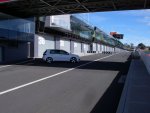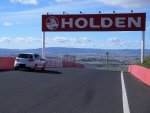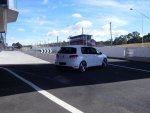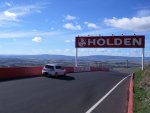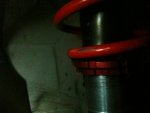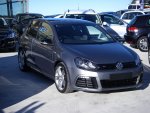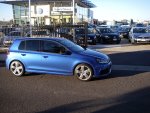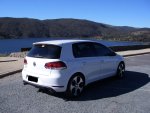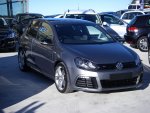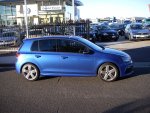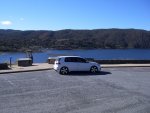V
You are using an out of date browser. It may not display this or other websites correctly.
You should upgrade or use an alternative browser.
You should upgrade or use an alternative browser.
WHITE JAMES: Suspension & Wheel Reviews
- Thread starter WhiteJames
- Start date
WhiteJames
Fun Nazi
- Location
- Sydney
- Car(s)
- VW Golf GTI MKV
New MK6 –v- Old MK5
EDL and XDS:
The Mark 6 GTI has 4 improvements over the MKV GTI. The hollow rear anti-roll bar on the MK6 is 2mm larger at 24mm. Secondly – EDL which apportions torque to the outside loaded wheel/tyre coupled with XDS electronic diff that applies the brake to reduce understeer at higher speeds – most people called both XDS, although EDL works at lower speeds and XDS at higher speeds. There is no need for concern about the brake heating up or wearing out with XDS as there is a sensor that switches off the brake/traction control should this occur (i.e. track use, hill climb, mountain pass). Thirdly – slightly higher front spring rate which compensates to a degree for the upgraded rear anti-roll bar. The front anti-roll bar is the same for both the MK6 and MK5. Fourthly, extra damping rate front & rear. Lastly: The MK6 has some extra chassis stiffness over the MK5 GTI.
Changes in the MK6 cause the GTI to corner flatter than the MK5 GTI. The MK5 would roll onto it’s outside front tyre with positive camber change, scrubbing & tearing the outside of the tyre out. The larger rear anti-roll bar in cohort with the stiffer front springs has made a reduction in understeer on the MK6 GTI. The steering wheel on the MK6 requires less effort & stabs at it to corner and the GTI feels closer to the Aussie offerings of the Falcon/Commodore in terms of amount of understeer (although with no power oversteer). Steering around bends on the MK6 has a greater fluidity about it, with the driver being able to make a smoother arc around a bend.
The MKV GTI/R32 was harder work in this regard when pressing on. Leaving the front sway bar the same size as the MKV GTI and upping the spring rate allows for greater independence of the front wheels of the MK6 GTI, improving grip levels of each wheel over irregular surfaces – in additional to EDL and XDS.
When the MK6 GTI feels like understeering, the EDL/XDS diff steps in to pull the GTI into the corner, taking the driver out of the equation to a degree. The experience leaves the driver thinking, ‘what just happened? Am I missing a couple of seconds of driving?”
Driving up steep tight bends, such as those found in Kangaroo Valley, inland of Wollongong, NSW – I noticed that the MK6 GTI does not spin the inside front wheel. Even at slow speeds, the inside wheel has less distance to travel around a bend than the outside wheel, causing the inside wheel to spin up at any speed. The lack of wheel spin in this type of driving would be attributable to the XDS electronic diff applying slight & imperceptible brake pressure to the inside wheel to stop it from losing traction in addition to forcing the torque to the outside wheel.
Note that although the GTI doesn’t feel like an AWD R32 or Tiguan – grip levels are enhanced considerably on the MK6 front wheel drive GTI. In 1500km of wet weather driving, I haven’t seen the traction control light appear – even when driving in the wet uphill through valleys.
Given that driving around a tight corner, you’d expect the inside wheel to spin up to a small degree as the outside wheel has to travel further around a larger arc, causing the inside wheel to unload. Not the case so far in the MK6 GTI. Bear in mind driving & throttle application have been gentle to date. The MK6 is definitely an improvement over the MK5 for ease of driving & grips levels.
DSG: MKV -v- MKVI
When the brake is applied going down-hills with the DSG in ‘Drive’, the DSG knocks down by a couple of gears to allow for some engine-braking.
At first, I thought there was a problem with the gearbox or megatronic unit – I don’t believe this is not the case as I’ve read reviews indicating this type of DSG behaviour.
The old MKV GTI DSG was not programmed to do this.
The Mark 6 DSG is proactive in Drive as well as Sport function.
Sometimes the down change in gears is not always welcomed, esp. when its two gears at a time.
Cheers
WJ
EDL and XDS:
The Mark 6 GTI has 4 improvements over the MKV GTI. The hollow rear anti-roll bar on the MK6 is 2mm larger at 24mm. Secondly – EDL which apportions torque to the outside loaded wheel/tyre coupled with XDS electronic diff that applies the brake to reduce understeer at higher speeds – most people called both XDS, although EDL works at lower speeds and XDS at higher speeds. There is no need for concern about the brake heating up or wearing out with XDS as there is a sensor that switches off the brake/traction control should this occur (i.e. track use, hill climb, mountain pass). Thirdly – slightly higher front spring rate which compensates to a degree for the upgraded rear anti-roll bar. The front anti-roll bar is the same for both the MK6 and MK5. Fourthly, extra damping rate front & rear. Lastly: The MK6 has some extra chassis stiffness over the MK5 GTI.
Changes in the MK6 cause the GTI to corner flatter than the MK5 GTI. The MK5 would roll onto it’s outside front tyre with positive camber change, scrubbing & tearing the outside of the tyre out. The larger rear anti-roll bar in cohort with the stiffer front springs has made a reduction in understeer on the MK6 GTI. The steering wheel on the MK6 requires less effort & stabs at it to corner and the GTI feels closer to the Aussie offerings of the Falcon/Commodore in terms of amount of understeer (although with no power oversteer). Steering around bends on the MK6 has a greater fluidity about it, with the driver being able to make a smoother arc around a bend.
The MKV GTI/R32 was harder work in this regard when pressing on. Leaving the front sway bar the same size as the MKV GTI and upping the spring rate allows for greater independence of the front wheels of the MK6 GTI, improving grip levels of each wheel over irregular surfaces – in additional to EDL and XDS.
When the MK6 GTI feels like understeering, the EDL/XDS diff steps in to pull the GTI into the corner, taking the driver out of the equation to a degree. The experience leaves the driver thinking, ‘what just happened? Am I missing a couple of seconds of driving?”
Driving up steep tight bends, such as those found in Kangaroo Valley, inland of Wollongong, NSW – I noticed that the MK6 GTI does not spin the inside front wheel. Even at slow speeds, the inside wheel has less distance to travel around a bend than the outside wheel, causing the inside wheel to spin up at any speed. The lack of wheel spin in this type of driving would be attributable to the XDS electronic diff applying slight & imperceptible brake pressure to the inside wheel to stop it from losing traction in addition to forcing the torque to the outside wheel.
Note that although the GTI doesn’t feel like an AWD R32 or Tiguan – grip levels are enhanced considerably on the MK6 front wheel drive GTI. In 1500km of wet weather driving, I haven’t seen the traction control light appear – even when driving in the wet uphill through valleys.
Given that driving around a tight corner, you’d expect the inside wheel to spin up to a small degree as the outside wheel has to travel further around a larger arc, causing the inside wheel to unload. Not the case so far in the MK6 GTI. Bear in mind driving & throttle application have been gentle to date. The MK6 is definitely an improvement over the MK5 for ease of driving & grips levels.
DSG: MKV -v- MKVI
When the brake is applied going down-hills with the DSG in ‘Drive’, the DSG knocks down by a couple of gears to allow for some engine-braking.
At first, I thought there was a problem with the gearbox or megatronic unit – I don’t believe this is not the case as I’ve read reviews indicating this type of DSG behaviour.
The old MKV GTI DSG was not programmed to do this.
The Mark 6 DSG is proactive in Drive as well as Sport function.
Sometimes the down change in gears is not always welcomed, esp. when its two gears at a time.
Cheers
WJ
Attachments
WhiteJames
Fun Nazi
- Location
- Sydney
- Car(s)
- VW Golf GTI MKV
New -v- Old
Which is the better drive?
The new MK6 GTI (DCC) –v- The old MK5 (KW V3/H&R)?
City:
Around town the Mark 6 DCC equipped GTI wins hands down. Being able to select ‘Comfort’ mode around town on the fly offer more comfort than either of the two aftermarket kits (Eibach/FSD – KW V3) on the old MKV GTI.
DCC in ‘Normal’ mode is similar to the Eibach/FSD combo and DCC ‘Sport’ mode gives firmer damping than the Eibach/Prokit package about the same spring rate (hard to compare progressive –v- linear OE springs).
KW V3 was in another league of firmness regarding damping & spring rates and not ideal for a daily cruiser imo.
Freeway:
DCC Mark 6 GTI wins by a very slight margin on freeway (more so concrete freeways) in a tightly fought contest. DCC has ‘Comfort’ for even concrete freeway joints and ‘Sport’ for the smooth bitumen. In other words, the DCC wins on its adjustability and ease of adjustability.
DCC also wins in the steering department with the steering being able to be firmed up considerably in ‘Sport’ mode. When heavier Sport mode steering is mated with the harder Sport damper setting with some factory induced understeer that is okay at higher freeway speeds, the MK6 DCC GTI feels very good indeed – confident, inspiring & reassuring at higher speeds. The MK6 GTI steering on Comfort and Normal modes is feels lighter than the MKV GTI steering. Steering on Sport mode is firmer than the MKV GTI/Comfort/Normal by a good margin.
The KW V3 would come in second place due to the higher linear cone shaped spring rate not suffering in ride comfort on smooth roadways as it does in the city or on terrible B’grade tarmac. This kit also offer supreme control, but can be firm & very telegraphic of roadway imperfections, even on smooth freeways.
Eibach/Koni FSD lagging behind in third place due to the hovercraft initial softness of the progressive rate strut springs, initial overdamping earlier in the spring compression rate and less overall chassis control. The Eibach Prokit/FSD combo can lean heavily on its outside front wheels compared to the MK6 DCC and KW V3 coil over.
B-Grade Roadway:
Eibach Prokit/Koni FSD (or rather HPA KW SHS coil over) wins on the bad side of the B-grade roadway. The Koni FSD damper has it’s high speed compression setting giving a softer ride than the DCC in ‘Comfort’ mode. From Comfort – Normal – Sport the DCC modes vary slightly, but notably after being driven for extended periods of time. Changes in damping rates is nothing like turning up a KW V3 from 10% - 50% damping rate; where at 50% the KW V3 does not appear to move under harder braking, race car style.
I would not opt for the Eibach Prokit/Koni FSD kit due to the excessive noise of spring bind that they exhibit - Not on a 50 grand vehicle; although ProKit/FSD does offer supreme ride over harsh B-grade routes like Captains Flat Road (Go the HPA Motorsport KW SHS coil over or KW Comfort coil over instead for better NVH & linear front spring rates).
DCC comes in at second position as it does not soften up sufficiently enough to match the trademark Koni FSD carpet type of ride on rougher B’grade bitumen. The DCC suspension offers damper valving more in line with Sachs/H&R suspension (I think they are made by Boge-Sachs).
The sport focussed KW V3 being a distant third place (even when on almost full soft adjustment) as the slow speed compression is still firmer than the DCC in Sport, although high speed compression is somewhere between DCC - Normal to Sport - mode.
Tourist Drive:
The MKV GTI with the KW Variant 3 coil over and H&R sway bars is the better drive than the MK6 DCC GTI. The lower ride height, stiffer springs & damping is a factor, but not the biggest factor in the KW V3 win. The aftermarket H&R solid adjustable anti-roll bars with front on soft and rear on hard made the old MKV GTI near neutral in chassis tune. Nothing beats a near neutral chassis tune for the ultimate in driver connection & satisfaction. The KW V3 – H&R aftermarket kit makes for a fantastic drive, providing the tourist route is a reasonably smooth roadway (wet weather excepted).
The MK6 DCC GTI on ‘Sport’ setting with XDS electronic diff simply doesn’t provide the thrills & driver involvement that the old MKV KW V3/H&R GTI did. The KW V3 with H&R sway bars was more fluid to drive with a direct feel. Hustling the KW V3/H&R MKV GTI was a breeze on dry roadways.
When the XDS on the Mark 6 intervenes to tighten the vehicles line, the KW V3 with H&R sway bars would often be in trail braking lift off oversteer with the chassis turning from it’s central axis like a downhill skier. This makes for a more engaging drive, but at times unnerving when you find yourself steering in the opposite direction on corner entry. The KW V3/H&R MKV GTI, although inert under 7/10ths, really delivered from when leaned on from 8/10ths onwards.
Disadvantages of the KW V3 coil over suspension kit is that, like many sports biased suspension kits, they can be stiffed legged around town & on harsher B’grade roadways, sometimes pogo over high frequency undulations and be harsher when striking uneven concrete joints. With the KW V3 sports coil over kit – there certainly was a tangible trade-off in comfort for sports handling.
Cheers
WJ
Which is the better drive?
The new MK6 GTI (DCC) –v- The old MK5 (KW V3/H&R)?
City:
Around town the Mark 6 DCC equipped GTI wins hands down. Being able to select ‘Comfort’ mode around town on the fly offer more comfort than either of the two aftermarket kits (Eibach/FSD – KW V3) on the old MKV GTI.
DCC in ‘Normal’ mode is similar to the Eibach/FSD combo and DCC ‘Sport’ mode gives firmer damping than the Eibach/Prokit package about the same spring rate (hard to compare progressive –v- linear OE springs).
KW V3 was in another league of firmness regarding damping & spring rates and not ideal for a daily cruiser imo.
Freeway:
DCC Mark 6 GTI wins by a very slight margin on freeway (more so concrete freeways) in a tightly fought contest. DCC has ‘Comfort’ for even concrete freeway joints and ‘Sport’ for the smooth bitumen. In other words, the DCC wins on its adjustability and ease of adjustability.
DCC also wins in the steering department with the steering being able to be firmed up considerably in ‘Sport’ mode. When heavier Sport mode steering is mated with the harder Sport damper setting with some factory induced understeer that is okay at higher freeway speeds, the MK6 DCC GTI feels very good indeed – confident, inspiring & reassuring at higher speeds. The MK6 GTI steering on Comfort and Normal modes is feels lighter than the MKV GTI steering. Steering on Sport mode is firmer than the MKV GTI/Comfort/Normal by a good margin.
The KW V3 would come in second place due to the higher linear cone shaped spring rate not suffering in ride comfort on smooth roadways as it does in the city or on terrible B’grade tarmac. This kit also offer supreme control, but can be firm & very telegraphic of roadway imperfections, even on smooth freeways.
Eibach/Koni FSD lagging behind in third place due to the hovercraft initial softness of the progressive rate strut springs, initial overdamping earlier in the spring compression rate and less overall chassis control. The Eibach Prokit/FSD combo can lean heavily on its outside front wheels compared to the MK6 DCC and KW V3 coil over.
B-Grade Roadway:
Eibach Prokit/Koni FSD (or rather HPA KW SHS coil over) wins on the bad side of the B-grade roadway. The Koni FSD damper has it’s high speed compression setting giving a softer ride than the DCC in ‘Comfort’ mode. From Comfort – Normal – Sport the DCC modes vary slightly, but notably after being driven for extended periods of time. Changes in damping rates is nothing like turning up a KW V3 from 10% - 50% damping rate; where at 50% the KW V3 does not appear to move under harder braking, race car style.
I would not opt for the Eibach Prokit/Koni FSD kit due to the excessive noise of spring bind that they exhibit - Not on a 50 grand vehicle; although ProKit/FSD does offer supreme ride over harsh B-grade routes like Captains Flat Road (Go the HPA Motorsport KW SHS coil over or KW Comfort coil over instead for better NVH & linear front spring rates).
DCC comes in at second position as it does not soften up sufficiently enough to match the trademark Koni FSD carpet type of ride on rougher B’grade bitumen. The DCC suspension offers damper valving more in line with Sachs/H&R suspension (I think they are made by Boge-Sachs).
The sport focussed KW V3 being a distant third place (even when on almost full soft adjustment) as the slow speed compression is still firmer than the DCC in Sport, although high speed compression is somewhere between DCC - Normal to Sport - mode.
Tourist Drive:
The MKV GTI with the KW Variant 3 coil over and H&R sway bars is the better drive than the MK6 DCC GTI. The lower ride height, stiffer springs & damping is a factor, but not the biggest factor in the KW V3 win. The aftermarket H&R solid adjustable anti-roll bars with front on soft and rear on hard made the old MKV GTI near neutral in chassis tune. Nothing beats a near neutral chassis tune for the ultimate in driver connection & satisfaction. The KW V3 – H&R aftermarket kit makes for a fantastic drive, providing the tourist route is a reasonably smooth roadway (wet weather excepted).
The MK6 DCC GTI on ‘Sport’ setting with XDS electronic diff simply doesn’t provide the thrills & driver involvement that the old MKV KW V3/H&R GTI did. The KW V3 with H&R sway bars was more fluid to drive with a direct feel. Hustling the KW V3/H&R MKV GTI was a breeze on dry roadways.
When the XDS on the Mark 6 intervenes to tighten the vehicles line, the KW V3 with H&R sway bars would often be in trail braking lift off oversteer with the chassis turning from it’s central axis like a downhill skier. This makes for a more engaging drive, but at times unnerving when you find yourself steering in the opposite direction on corner entry. The KW V3/H&R MKV GTI, although inert under 7/10ths, really delivered from when leaned on from 8/10ths onwards.
Disadvantages of the KW V3 coil over suspension kit is that, like many sports biased suspension kits, they can be stiffed legged around town & on harsher B’grade roadways, sometimes pogo over high frequency undulations and be harsher when striking uneven concrete joints. With the KW V3 sports coil over kit – there certainly was a tangible trade-off in comfort for sports handling.
Cheers
WJ
Attachments
WhiteJames
Fun Nazi
- Location
- Sydney
- Car(s)
- VW Golf GTI MKV
Mount Panorama - Bathurst
With a view to the breaking-in of the TSI motor, the GTI was taken for a run out from Sydney to Bathurst and Mount Panorama.
Additional time was spent sampling the different modes of the Dynamic Chassis Control (DCC).
The trip to Bathurst allowed some time to lean on the chassis through some nice flowing 60kph - 80kph bends in addition to driving on a variety of roadways and roadway textures in dry conditions with the temperature ranging from 8.0 degrees Celsius to 20 degree Celsius.
1. DCC Sport:
DCC in Sport mode as the default setting for motorways: M4, M5 and M7. With exception of the motorways, about 1/3 of the trip could be driven in Sport mode. The majority single lane highway was smooth enough to allow for this, as was the Mount Panorama. Sport mode also became the preferred setting for tight bends running through the great dividing mountain range. The GTI really began to impress with the chassis sitting flat, with the larger rear anti-roll bar and EDL/XDS making a notable reduction in understeer in the mountain bends. This is the first completely dry day that the GTI has driven in – the earlier drives were in wet or damp roadway conditions. I did get caught out on in Sport mode on a section of rutted roadwork that was initially not pleasant until I managed to fumble out Comfort mode. On smoother roadways and travelling around 100kph and above, the Sport mode is the setting to have, keeping the GTI firmly planted to the roadway, especially when it came to overtaking slow moving vehicles. The firmer Sport mode steering also assists in this regard as the steering is more direct and requires less driver input to achieve the same or better result than the two softer modes. Sport mode did offer too heavy steering for suburban roundabouts; the heavy Sport steering improves with speed.
2. DCC Normal:
The in-between Normal mode was chosen for 1/3 of the country drive. This was for when Sport was too punishing and Comfort felt too loose and uncontrolled. Steering could still do with a tad more weight in Normal. All roadways being equal in smoothness & texture, Normal mode is good for speeds between 60kph and 100kph. At lower speeds the damping can be a tad firm, with Normal at higher speeds not as confidence inspiring or stable as Sport.
3. DCC Comfort:
Comfort was the default setting for Bathurst City. This country city had rough roadways in the centre of town, which had me thinking about ditching the 18” Detroit Wheels for 17” Denver in addition to running DCC permanently in Comfort mode. In Normal mode in Bathurst CBD, the relationship with the GTI was becoming strained with the GTI beginning to feel nuggetty & stiff legged: GTI + Normal Mode + 18” Wheels = Too Firm for Bathurst Country. Comfort mode was also the default for any road works encountered along the way and was used intermittently throughout 1/3 of the trip when the roadway quality deteriorated or was very undulating. The low-speed compression and rebound of Comfort mode in riding over a series of continuous bitumen patchwork along was fantastic – not quite a carpet smooth Koni ride, but not far off on the Great Western Highway . All roadways being equal – Comfort mode is great at speeds under 70kph – but any more than 70kph and comfort does compromise handling, agility and steering with lessvertical body control , chassis roll in corners exhibiting a bit of additional understeer over Normal or Sport– this does rob the driver of some confidence.
Result:
On a trip from Sydney to Bathurst and return – each setting was used for about 1/3 of the time (Motorways M4, M5 and M7 excepted).
Other Issues:
The B-pillar plastic strip around the seat belt strap holder has developed a squeaking noise, which was also a problem with the old MKV GTI. A plastic rubbing against plastic type of sound. Disappointing that Volkswagen did not correct this. Some noise could also be coming from the base of the passenger’s front seat.
Oil Temperature ranged from 93 degrees to 105 degrees for the duration of this drive.
Fuel consumption was 6.9 litres per 100km – already better than the MKV GTI.
The Mark 6 GTI requires 38 psi in the Bridgestone RE050A tyres – the old Mark 5 GTI only required 35-36psi (extra weight of the MK6).
Don’t miss the leather interior at all – money well spent on Bi-Xenon’s & Park Assist. Cloth has added support & comfort.
The exhaust scavenging resonating sound between 2400rpm-2500rpm was heard intermittently on this trip. The rougher coarse chip bitumen drowns out the hissing sound. The resonation is easy to hear when driving around Mount Panorama that is bordered by concrete walls.
At sea level with humid air, the Mark 6 GTI feels sluggish. At higher altitude with cool dry air, the GTI feels more powerful with greater crispness to acceleration.
The GTI does have a hint of torque-steer, esp. in the higher gears (3-6) and compared to the MKV GTI. This suggests to me that more than 280Nm of torque is being put through the front wheels – perhaps more like @ 300Nm.
Old EA113 Mark 5 GTI motor felt more crisp and linear, esp. off boost. New EA888 Audi developed TSI motor in the Mark 6 GTI has greater punch in the mid-range, but feels slightly retarded in spark timing (maybe due to being 95RON compatible instead of 98RON).
Bathurst’s Mount Panorama always has the element of the unknown – like coming across an EMU on approach to Skyline on top of the hill.
Cheers
WJ
With a view to the breaking-in of the TSI motor, the GTI was taken for a run out from Sydney to Bathurst and Mount Panorama.
Additional time was spent sampling the different modes of the Dynamic Chassis Control (DCC).
The trip to Bathurst allowed some time to lean on the chassis through some nice flowing 60kph - 80kph bends in addition to driving on a variety of roadways and roadway textures in dry conditions with the temperature ranging from 8.0 degrees Celsius to 20 degree Celsius.
1. DCC Sport:
DCC in Sport mode as the default setting for motorways: M4, M5 and M7. With exception of the motorways, about 1/3 of the trip could be driven in Sport mode. The majority single lane highway was smooth enough to allow for this, as was the Mount Panorama. Sport mode also became the preferred setting for tight bends running through the great dividing mountain range. The GTI really began to impress with the chassis sitting flat, with the larger rear anti-roll bar and EDL/XDS making a notable reduction in understeer in the mountain bends. This is the first completely dry day that the GTI has driven in – the earlier drives were in wet or damp roadway conditions. I did get caught out on in Sport mode on a section of rutted roadwork that was initially not pleasant until I managed to fumble out Comfort mode. On smoother roadways and travelling around 100kph and above, the Sport mode is the setting to have, keeping the GTI firmly planted to the roadway, especially when it came to overtaking slow moving vehicles. The firmer Sport mode steering also assists in this regard as the steering is more direct and requires less driver input to achieve the same or better result than the two softer modes. Sport mode did offer too heavy steering for suburban roundabouts; the heavy Sport steering improves with speed.
2. DCC Normal:
The in-between Normal mode was chosen for 1/3 of the country drive. This was for when Sport was too punishing and Comfort felt too loose and uncontrolled. Steering could still do with a tad more weight in Normal. All roadways being equal in smoothness & texture, Normal mode is good for speeds between 60kph and 100kph. At lower speeds the damping can be a tad firm, with Normal at higher speeds not as confidence inspiring or stable as Sport.
3. DCC Comfort:
Comfort was the default setting for Bathurst City. This country city had rough roadways in the centre of town, which had me thinking about ditching the 18” Detroit Wheels for 17” Denver in addition to running DCC permanently in Comfort mode. In Normal mode in Bathurst CBD, the relationship with the GTI was becoming strained with the GTI beginning to feel nuggetty & stiff legged: GTI + Normal Mode + 18” Wheels = Too Firm for Bathurst Country. Comfort mode was also the default for any road works encountered along the way and was used intermittently throughout 1/3 of the trip when the roadway quality deteriorated or was very undulating. The low-speed compression and rebound of Comfort mode in riding over a series of continuous bitumen patchwork along was fantastic – not quite a carpet smooth Koni ride, but not far off on the Great Western Highway . All roadways being equal – Comfort mode is great at speeds under 70kph – but any more than 70kph and comfort does compromise handling, agility and steering with lessvertical body control , chassis roll in corners exhibiting a bit of additional understeer over Normal or Sport– this does rob the driver of some confidence.
Result:
On a trip from Sydney to Bathurst and return – each setting was used for about 1/3 of the time (Motorways M4, M5 and M7 excepted).
Other Issues:
The B-pillar plastic strip around the seat belt strap holder has developed a squeaking noise, which was also a problem with the old MKV GTI. A plastic rubbing against plastic type of sound. Disappointing that Volkswagen did not correct this. Some noise could also be coming from the base of the passenger’s front seat.
Oil Temperature ranged from 93 degrees to 105 degrees for the duration of this drive.
Fuel consumption was 6.9 litres per 100km – already better than the MKV GTI.
The Mark 6 GTI requires 38 psi in the Bridgestone RE050A tyres – the old Mark 5 GTI only required 35-36psi (extra weight of the MK6).
Don’t miss the leather interior at all – money well spent on Bi-Xenon’s & Park Assist. Cloth has added support & comfort.
The exhaust scavenging resonating sound between 2400rpm-2500rpm was heard intermittently on this trip. The rougher coarse chip bitumen drowns out the hissing sound. The resonation is easy to hear when driving around Mount Panorama that is bordered by concrete walls.
At sea level with humid air, the Mark 6 GTI feels sluggish. At higher altitude with cool dry air, the GTI feels more powerful with greater crispness to acceleration.
The GTI does have a hint of torque-steer, esp. in the higher gears (3-6) and compared to the MKV GTI. This suggests to me that more than 280Nm of torque is being put through the front wheels – perhaps more like @ 300Nm.
Old EA113 Mark 5 GTI motor felt more crisp and linear, esp. off boost. New EA888 Audi developed TSI motor in the Mark 6 GTI has greater punch in the mid-range, but feels slightly retarded in spark timing (maybe due to being 95RON compatible instead of 98RON).
Bathurst’s Mount Panorama always has the element of the unknown – like coming across an EMU on approach to Skyline on top of the hill.
Cheers
WJ
Attachments
Last edited:
order last 1
Passed Driver's Ed
- Location
- ACT
- Car(s)
- GTI Pirelli
Nice write up, Jame!
What, rattle noise again. Thought that was due to poor building quility in South Africa for our Mk5. Very disappointing that even Mk6 has this issue.
What, rattle noise again. Thought that was due to poor building quility in South Africa for our Mk5. Very disappointing that even Mk6 has this issue.
WhiteJames
Fun Nazi
- Location
- Sydney
- Car(s)
- VW Golf GTI MKV
Coilovers + Ride Height
We touched on this topic before as Roaming Nick from Singapore was experimenting with varied springs for his Sachs Adjustable Coilovers. This thread on 'Spring Bind' highlights that some coilovers (in this case the H&R SPC) work better within a certain height range. In this case: the vehicle was lowered in ride height to prevent spring bind at higher speeds on the track.
See link:
http://www.golfmk6.com/forums/showthread.php?t=6334
Part of the reason why I'd opt for the KW Comfort Coilover for the Mark 6 GTI - the ideal height range would be higher for an owner looking for only a mild drop in height of 10-15mm (1/2 inch). Not to mention better ride. The KW Comfort Coilover would still ride firmer than a set of Monroe Sport GTI Gas Struts (everything is relative). Kits like KW Comfort or HPA Motorsport KW SHS are designed to give better ride & handling than a stock Golf GTI, with the added benefit being able to set ride height.
Cheers
WJ
We touched on this topic before as Roaming Nick from Singapore was experimenting with varied springs for his Sachs Adjustable Coilovers. This thread on 'Spring Bind' highlights that some coilovers (in this case the H&R SPC) work better within a certain height range. In this case: the vehicle was lowered in ride height to prevent spring bind at higher speeds on the track.
No clunk and release at low speeds... this was only at high speed hard cornering...were the spring would compress into itself making the sounds and you can see in the picture were the spring's powder coat was getting rubbed off because it hit the coil right above it with very very very hard cornering... I have seen the coil above it that shows corresponding wear, but no pic.Like I said, after making it lower, no more issues... and I've proven it on the track as well...If you follow the link, you'll see pictures of how compressed I can get this on the track now and I'm having no issues anymore.
See link:
http://www.golfmk6.com/forums/showthread.php?t=6334
Part of the reason why I'd opt for the KW Comfort Coilover for the Mark 6 GTI - the ideal height range would be higher for an owner looking for only a mild drop in height of 10-15mm (1/2 inch). Not to mention better ride. The KW Comfort Coilover would still ride firmer than a set of Monroe Sport GTI Gas Struts (everything is relative). Kits like KW Comfort or HPA Motorsport KW SHS are designed to give better ride & handling than a stock Golf GTI, with the added benefit being able to set ride height.
Cheers
WJ
Attachments
Part of the reason why I'd opt for the KW Comfort Coilover for the Mark 6 GTI - the ideal height range would be higher for an owner looking for only a mild drop in height of 10-15mm (1/2 inch). Not to mention better ride. The KW Comfort Coilover would still ride firmer than a set of Monroe Sport GTI Gas Struts (everything is relative). Kits like KW Comfort or HPA Motorsport KW SHS are designed to give better ride & handling than a stock Golf GTI, with the added benefit being able to set ride height.
NOt sure on these comments- are you saying it could be better than the OEM ACC/DCC setup? I think it's very good to be honest, would be hard to match with an aftermarket setup which would handle possibly better but would be quite firm all the time.
WhiteJames
Fun Nazi
- Location
- Sydney
- Car(s)
- VW Golf GTI MKV
The Mark 6 Dynamic Chassis Control (DCC) is the ducks guts of suspension.
DCC - Being able to change damper rates, albeit only marginally, on the fly, is a fantastic option to have, as my country travels have highlighted. The OE DCC dampers feel as if they are the std Boge-Sachs dampers that have a Sachs/H&R/Bilstein feel about them in their valving.
The KW coilover kits basically have Koni valving that makes concessions in some roadway feel to allow for a greater disparity in low speed compression rate and high speed compression rate of the damper - KW are sort of like a Koni FSD coilover.
Koni are renouned for making firm, but good riding dampers, even the std red are very good in this regard (they too are firmer than the Monroe Sport GTI Gas on Falcondores with Sports Suspension).
When Jester_Fu put his HPA Motorsport Street Handling System (SHS) KW coilover on this R32 - it improved both ride and handling. Others with Pirelli GTI that are suppose to be a tad stiffer than a regular GTI are saying that they have a slight improvement in handling, with a notable improvement in ride that eliminates the crashing, jarring & banging.
In contrast, the H&R/Bilstein fixed rate coilovers ride a lot rougher than the KW equivalents as the compression rates between low speed & high speed compression valving due not vary as much - unlike the pronounced difference in low speed and high speed compression rates of the KW coilover and Koni FSD.
I think KW saw a market opportunity with the HPA KW SHS that was exclusive to HPA Motorsport and decided to release a KW Comfort Coilover kit for the Mark 6 Golf/GTI - only with rebound adjustment for some added fine tuning.
Alternatively:
If I was to run my GTI in NORMAL mode on the DCC -v- a KW Comfort Coilover with @ 10% rebound dialed in, the KW coilover would be the pic for ride and handling, but perhaps not quite as feelsome as the Mark 6 due to different valving in the damper rate.
My KW V3 was riding almost as good in low speed compression and better in high speed compression, only with a lot more control -v- my neighbours MKV 32 (we both had H&R anti-roll bars).
Cheers.
WJ
DCC - Being able to change damper rates, albeit only marginally, on the fly, is a fantastic option to have, as my country travels have highlighted. The OE DCC dampers feel as if they are the std Boge-Sachs dampers that have a Sachs/H&R/Bilstein feel about them in their valving.
The KW coilover kits basically have Koni valving that makes concessions in some roadway feel to allow for a greater disparity in low speed compression rate and high speed compression rate of the damper - KW are sort of like a Koni FSD coilover.
Koni are renouned for making firm, but good riding dampers, even the std red are very good in this regard (they too are firmer than the Monroe Sport GTI Gas on Falcondores with Sports Suspension).
When Jester_Fu put his HPA Motorsport Street Handling System (SHS) KW coilover on this R32 - it improved both ride and handling. Others with Pirelli GTI that are suppose to be a tad stiffer than a regular GTI are saying that they have a slight improvement in handling, with a notable improvement in ride that eliminates the crashing, jarring & banging.
In contrast, the H&R/Bilstein fixed rate coilovers ride a lot rougher than the KW equivalents as the compression rates between low speed & high speed compression valving due not vary as much - unlike the pronounced difference in low speed and high speed compression rates of the KW coilover and Koni FSD.
I think KW saw a market opportunity with the HPA KW SHS that was exclusive to HPA Motorsport and decided to release a KW Comfort Coilover kit for the Mark 6 Golf/GTI - only with rebound adjustment for some added fine tuning.
Alternatively:
If I was to run my GTI in NORMAL mode on the DCC -v- a KW Comfort Coilover with @ 10% rebound dialed in, the KW coilover would be the pic for ride and handling, but perhaps not quite as feelsome as the Mark 6 due to different valving in the damper rate.
My KW V3 was riding almost as good in low speed compression and better in high speed compression, only with a lot more control -v- my neighbours MKV 32 (we both had H&R anti-roll bars).
Cheers.
WJ
WhiteJames
Fun Nazi
- Location
- Sydney
- Car(s)
- VW Golf GTI MKV
Golf R -v- Golf GTI
Golf R –v- Golf GTI
I stopped by Gerald Slaven Volkswagen, Belconnen, ACT and Sales Manager Phil Fairhall was kind enough to allow me to take the new Mark 6 Golf R for a test drive on a whim. I set a few conditions on Manager Phil Fairhall – the Golf R had to be test driven along a challenging B’grade roadway with some ascents, descents, and a few tight twisties, in addition to the odd National Capitol roundabout. This is not Manager Phil’s usual 10km test drive route and I wanted to see if the Golf R would cope with some rural type B’grade roadways. The new Volkswagen Golf R had @ 150kms on the odometer and had been test driven several times over during this day. I predominately used the DSG shift paddles on the otherwise un-optioned 5 door Blue Golf R with 18’ wheels (see pics in WJ Suspension & Wheel Thread for pics).
In contrast, immediately after the test drive of the Golf R, I drove the same route in my own Mark 6 Golf GTI DSG with DCC on ‘Normal’ mode & riding on 18” Detroit Wheels. The Golf GTI was not revved past 4500rpm as it’s in the process of a particular type of break-in atm and has @ 2500km on the odometer.
One passenger was on board for both test runs in the Golf R and GTI.
Golf R:
First thing I noticed about the Golf R is that it felt as tight as a drum – very secure on its 20% stiffer than GTI springs. Taking off in Drive/Auto, it was immediately obvious that the power band of the Golf R’s EA113 KO4 motor exhibited low down lag compared to the EA888 motor in the MK6 GTI. The turbo lag in the Golf R was not excessive, but did involve a muted response to the throttle application and loss of feel. I’d attribute this to the less instant torque down low coupled with the added weight of the Golf R (@ 120kgs extra on GTI). When spooled up, the older belt cam driven EA113 KO4 motor of the Golf R did feel more refined & was quieter than the newer chain driven cam EA888 motor in the MK6 GTI. The fuel delivery of the Golf R didn’t feel as well metered as that in the MK6 GTI, but this was expected.
Driving out of Belconnen just behind Black Mountain Tower on suburban roadway with predominately 80kph posted limits, the 20% stiffer Golf R springs was riding in a similar manner as the Golf GTI, only with a touch more rebound in the spring rate and a greater tied down feeling. The Golf R felt that bit more Grand Tourer in ride.
Leaning on the Golf R between 20kph to 80kph showed a mix of linear surge forward, mated with a laggy feel lower in the rev range. It’s obvious that the max torque comes on song later in the rev range with the Golf R. Between 1000rpm and 3500rpm - 4000rpm, the Golf R motor is uninspiring. You’re moving forward, but without any sense of feeling, rather building up to a higher crescendo.
Once you straddle the 4000rpm to 6000rpm, the Golf R comes alive with some real strong thrust. The rpm gauge moves fast in this band of rpm, requiring some fast work on the DSG paddles. The final 4,000rpm from 6,000rpm onwards makes up for the lack-lusted feel below 4,000rpm. The power delivery of the Golf R does notably pin you into the seat back harder and for longer than in the MK6 GTI, but by no means is this thrust overwhelming.
Heading out to a rural mild B-grade roadway that borders Canberra had the Golf R riding the bumps surprisingly well for a vehicle that has 20% stiffer springs than the GTI. The extra weight helps the Golf R soak into the undulations, rather than riding or bouncing over them as in the case of the GTI.
Overall - I wouldn’t say that the Golf R riding on 18” wheels is superior or interior to the GTI in ride – but it does ride better over the smaller low speed compression bumps and has sufficient rebound rate in the springs & dampers to keep the chassis well contained. The suspension tune also offers enough compliance for mild to good B-grade roadways on this short B’grade roadway portion of the drive. Please note that this was a short test drive.
It was time to chuck the Golf R around a few tight twisting B’grade coarse bitumen corners in addition to dropping into and out of valleys to see how she handled.
The Haldex system on the new Mark 6 Golf R is superior to the Haldex system on the MKV R32 Golf. It is also superior to the aftermarket Generation III Haldex Controller that some owners fit to their R32 to improve the time it takes for the vehicle to apportion drive to the rear wheels. The shift from front wheel drive to rear wheel is almost imperceptible and the grip levels are very high. Mid corner grip levels do not feel to be as high as the Mark GTI, and it is debatable how much an advantage the Haldex AWD gives the Golf R over the electronic EDL/XDS differential of the Golf GTI. When applying the gas, the feeling of the Haldex AWD in the Golf R is certainly better than the FWD GTI.
To drive, the Golf R feels like a 50/50 AWD than a FWD shifting power to the rear wheel slip is detected as in the case of the earlier MKV R32 Golf. The drive experience of the Haldex Generation IV in the Golf R was certainly one of the highlights of my drive experience when pressing on in this portion of the B-grade roadway drive. It’s all very seem-less and fuss free.
Another highlight of driving the Golf R was the chassis balance.
The Golf R is definitely an improvement over the front heavy Golf R32, which exhibited much more understeer, swaying under heavy braking and with the occasional rub of the front top inner fender screw due carrying the heavy V6 motor up front. With 35kg less over the front axle than the MKV R32, the Golf R is beginning to feel more BMW 50/50 like in weight distribution. With the front to rear balance much improved over the previous model, the Golf R adds reassurance and ease of effort when hustling via a series of bends. The reduction in weight and improved weight distribution front to rear certainly improves grip levels over the outgoing R32 MKV Golf.
The larger diameter brakes on the Golf R (330mm/310mm) did not feel as sensitive as those on the new Mark 6 GTI. I had not a great deal of cause to lean on them, but for street driving, the retardation of the Golf R brakes –v- the GTI has the GTI feeling to have greater initial bite. The extra weight of the Golf R may have something to do with this, and for repeated stops, I’d be putting my money on the Golf R for consistency. The tyres on the Golf R and GTI seem to be about the same standard now, whereas the MKV GTI had tyres one step down in terms of performance in comparison with the R32 (i.e. Conti CS2 –v- Conti CS3; Dunlop Sport –v- Dunlop Sport Maxx, etc).
I conducted a test of tractability between the Golf R and Golf GTI. This involved dropping the speed to 20kph under the speed limit in top gear (6th) on approach to a long & steep hill. About half throttle would be applied to see if the vehicle would increase speed in ascending up this protracted climb. The Golf R failed to accelerate up the hill leading up to half throttle, maintaining a constant speed until a down change to 5th gear was required nearing the peak of the climb. This showed that the bigger turbo could not overcome its turbo lag to spool up enough towards maximum torque for the hill climb. This detracted from the driveability of the Golf R and is clear evidence that the Golf R requires revs to extract the best from it under pressing conditions. You wouldn’t want to be caught in the incorrect gear under load in the Golf R.
To be continued ...
Golf R –v- Golf GTI
I stopped by Gerald Slaven Volkswagen, Belconnen, ACT and Sales Manager Phil Fairhall was kind enough to allow me to take the new Mark 6 Golf R for a test drive on a whim. I set a few conditions on Manager Phil Fairhall – the Golf R had to be test driven along a challenging B’grade roadway with some ascents, descents, and a few tight twisties, in addition to the odd National Capitol roundabout. This is not Manager Phil’s usual 10km test drive route and I wanted to see if the Golf R would cope with some rural type B’grade roadways. The new Volkswagen Golf R had @ 150kms on the odometer and had been test driven several times over during this day. I predominately used the DSG shift paddles on the otherwise un-optioned 5 door Blue Golf R with 18’ wheels (see pics in WJ Suspension & Wheel Thread for pics).
In contrast, immediately after the test drive of the Golf R, I drove the same route in my own Mark 6 Golf GTI DSG with DCC on ‘Normal’ mode & riding on 18” Detroit Wheels. The Golf GTI was not revved past 4500rpm as it’s in the process of a particular type of break-in atm and has @ 2500km on the odometer.
One passenger was on board for both test runs in the Golf R and GTI.
Golf R:
First thing I noticed about the Golf R is that it felt as tight as a drum – very secure on its 20% stiffer than GTI springs. Taking off in Drive/Auto, it was immediately obvious that the power band of the Golf R’s EA113 KO4 motor exhibited low down lag compared to the EA888 motor in the MK6 GTI. The turbo lag in the Golf R was not excessive, but did involve a muted response to the throttle application and loss of feel. I’d attribute this to the less instant torque down low coupled with the added weight of the Golf R (@ 120kgs extra on GTI). When spooled up, the older belt cam driven EA113 KO4 motor of the Golf R did feel more refined & was quieter than the newer chain driven cam EA888 motor in the MK6 GTI. The fuel delivery of the Golf R didn’t feel as well metered as that in the MK6 GTI, but this was expected.
Driving out of Belconnen just behind Black Mountain Tower on suburban roadway with predominately 80kph posted limits, the 20% stiffer Golf R springs was riding in a similar manner as the Golf GTI, only with a touch more rebound in the spring rate and a greater tied down feeling. The Golf R felt that bit more Grand Tourer in ride.
Leaning on the Golf R between 20kph to 80kph showed a mix of linear surge forward, mated with a laggy feel lower in the rev range. It’s obvious that the max torque comes on song later in the rev range with the Golf R. Between 1000rpm and 3500rpm - 4000rpm, the Golf R motor is uninspiring. You’re moving forward, but without any sense of feeling, rather building up to a higher crescendo.
Once you straddle the 4000rpm to 6000rpm, the Golf R comes alive with some real strong thrust. The rpm gauge moves fast in this band of rpm, requiring some fast work on the DSG paddles. The final 4,000rpm from 6,000rpm onwards makes up for the lack-lusted feel below 4,000rpm. The power delivery of the Golf R does notably pin you into the seat back harder and for longer than in the MK6 GTI, but by no means is this thrust overwhelming.
Heading out to a rural mild B-grade roadway that borders Canberra had the Golf R riding the bumps surprisingly well for a vehicle that has 20% stiffer springs than the GTI. The extra weight helps the Golf R soak into the undulations, rather than riding or bouncing over them as in the case of the GTI.
Overall - I wouldn’t say that the Golf R riding on 18” wheels is superior or interior to the GTI in ride – but it does ride better over the smaller low speed compression bumps and has sufficient rebound rate in the springs & dampers to keep the chassis well contained. The suspension tune also offers enough compliance for mild to good B-grade roadways on this short B’grade roadway portion of the drive. Please note that this was a short test drive.
It was time to chuck the Golf R around a few tight twisting B’grade coarse bitumen corners in addition to dropping into and out of valleys to see how she handled.
The Haldex system on the new Mark 6 Golf R is superior to the Haldex system on the MKV R32 Golf. It is also superior to the aftermarket Generation III Haldex Controller that some owners fit to their R32 to improve the time it takes for the vehicle to apportion drive to the rear wheels. The shift from front wheel drive to rear wheel is almost imperceptible and the grip levels are very high. Mid corner grip levels do not feel to be as high as the Mark GTI, and it is debatable how much an advantage the Haldex AWD gives the Golf R over the electronic EDL/XDS differential of the Golf GTI. When applying the gas, the feeling of the Haldex AWD in the Golf R is certainly better than the FWD GTI.
To drive, the Golf R feels like a 50/50 AWD than a FWD shifting power to the rear wheel slip is detected as in the case of the earlier MKV R32 Golf. The drive experience of the Haldex Generation IV in the Golf R was certainly one of the highlights of my drive experience when pressing on in this portion of the B-grade roadway drive. It’s all very seem-less and fuss free.
Another highlight of driving the Golf R was the chassis balance.
The Golf R is definitely an improvement over the front heavy Golf R32, which exhibited much more understeer, swaying under heavy braking and with the occasional rub of the front top inner fender screw due carrying the heavy V6 motor up front. With 35kg less over the front axle than the MKV R32, the Golf R is beginning to feel more BMW 50/50 like in weight distribution. With the front to rear balance much improved over the previous model, the Golf R adds reassurance and ease of effort when hustling via a series of bends. The reduction in weight and improved weight distribution front to rear certainly improves grip levels over the outgoing R32 MKV Golf.
The larger diameter brakes on the Golf R (330mm/310mm) did not feel as sensitive as those on the new Mark 6 GTI. I had not a great deal of cause to lean on them, but for street driving, the retardation of the Golf R brakes –v- the GTI has the GTI feeling to have greater initial bite. The extra weight of the Golf R may have something to do with this, and for repeated stops, I’d be putting my money on the Golf R for consistency. The tyres on the Golf R and GTI seem to be about the same standard now, whereas the MKV GTI had tyres one step down in terms of performance in comparison with the R32 (i.e. Conti CS2 –v- Conti CS3; Dunlop Sport –v- Dunlop Sport Maxx, etc).
I conducted a test of tractability between the Golf R and Golf GTI. This involved dropping the speed to 20kph under the speed limit in top gear (6th) on approach to a long & steep hill. About half throttle would be applied to see if the vehicle would increase speed in ascending up this protracted climb. The Golf R failed to accelerate up the hill leading up to half throttle, maintaining a constant speed until a down change to 5th gear was required nearing the peak of the climb. This showed that the bigger turbo could not overcome its turbo lag to spool up enough towards maximum torque for the hill climb. This detracted from the driveability of the Golf R and is clear evidence that the Golf R requires revs to extract the best from it under pressing conditions. You wouldn’t want to be caught in the incorrect gear under load in the Golf R.
To be continued ...
Attachments
WhiteJames
Fun Nazi
- Location
- Sydney
- Car(s)
- VW Golf GTI MKV
Golf R -v- Golf GTI
Golf GTI:
The GTI has a tendency to skip, jump and bounce over a series of roadway irregularities due to the less kerb mass. The added weight of the Golf R is a welcomed addition in this respect, with a trade off in mid-corner grip levels & agility. The ride on the GTI is about the same as the Golf R on 18” wheels in some respects. Cross winds also has an adverse effect on the stability of the Golf GTI as higher speeds, due to its less kerb mass.
The Golf R doesn’t look any better than the Golf GTI, probably worse in my opinion, especially with the 18” wheels that look smaller than the 18” GTI Detroit Wheels. The 19” Golf R wheels on a 235 series tyre is guaranteed to rub against the top inner fender screw.
The new Audi developed EA888 TSI motor with more measured fuelling from the 4 lobe camshaft actuator and chain drive camshaft is noisier than the Golf R and MKV GTI EA113 motor. Timing chains will do this to a motor – in contrast, cam belts are quiet.
The Mark 6 GTI motor develops more torque early in its rev range, making for instant power, punch & crispness to throttle inputs & forward thrust as opposed to the Golf R, which feels devoid of feel and builds speed up in a strong linear fashion – a typical trait of the older EA113 motor.
The greater thrust in the lower rev band makes the GTI more user friendly around town and when tackling the tight twisties - the driver is not required to rev the motor as hard or to have the MK6 GTI in the correct gear to extract the maximum performance from the EA888 Audi developed motor. In contrast, being caught in the incorrect gear in the Golf R would have the Golf GTI jumping ahead, especially up inclines. Easily done in day to day traffic.
Driving the same route and conducting the same tractability test up the same hill, the GTI in top gear (6th) pulled cleanly and easily with increased speed on ascent with half or less than half throttle - whereas the Golf R was struggling to get into the meat of its torque band . Part of the Golf R’s problem is the added weight; the other issue is that the EA113 KO4 big turbo motor requires revs to perform; whereas the GTI motor does not require revs, as max torque starts at 1700rpm. The GTI was the clear winner on the protracted incline tractability test.
After driving the Golf R and Golf GTI back to back along the same route, I’m adamant that the torque figures stated for the Golf GTI are understated. I’d go out on the limb and say that the torque figure is more like 300Nm to 320Nm (in higher gears 3-6) of torque for the Mark 6 Golf GTI (Audi A4/A5 has 155kW/350Nm).
The Mark 6 Golf GTI felt so much stronger in the lower & mid range power delivery than the Golf R. Downside of the Golf GTI is that power tapers off @ 5500rpm, where the Golf R is hitting its stride up to 6500rpm. More revs does equate to higher fuel consumption.
It’s disappointing that Volkswagen have detuned the Golf GTI EA888 motor, making it feel less alive & linear than the previous MKV GTI (and Golf R) – 95 RON may have something to do with this. The new Golf GTI EA888 motor appears to be a motor than has the ability to be seriously tuned for large gains in power, judging by its mid-range punch on the Mark 6 GTI. The older EA113 VW developed motor in the Golf R feels like it’s at the end of its development cycle (which it is). Expect big gains in the forthcoming Mark 7 Golf R if it receives the new Mark 6 GTI EA888 motor.
The Golf GTI’s greatest asset is also its greatest liability – that is front wheel drive (FWD). FWD reduces weight, improving mid speed corner grip levels, agility, braking and responsiveness. On the hand, the GTI cannot shake that FWD feeling with a tad of torque steer on higher throttle applications, which appears to be more pronounced over the previous MK5 GTI, due to the greater mid range power thrust of the stronger EA888 motor.
After driving the Golf R, the GTI feels front heavy, with all the weight of the mechanicals up front. This can blunt the driving experience to a degree & sometimes can be downright annoying when powering on uphills – a constant reminder that you’ve purchased a FWD motor vehicle. A slow-in/fast-out approach to corners has to be adopted with the MK6 GTI when punting it through corners.
Where the Golf R relies on its natural chassis balance with improved weight distribution front to rear driving into corners. The GTI has to rely on its upgraded rear anti-roll bar (24mm hollow/tubular) and electronics such as EDL if it’s a slow speed corner (EDL applies brake forcing torque to the outside front wheel & prevent wheel spin) or XDS in the higher speed bends (XDS applies the brake to pull the GTI into the corner, reducing understeer). Both EDL and XDS in particular, make for added grip levels on the GTI, but take a certain amount of fun factor out of the driving experience.
Which has the better grip levels: GTI or Golf R? Hard to say as they both perform excellently in this regard & the Mark 6 GTI has improved substantially over the Mark 5 GTI in this area (remember that the Sirocco R has FWD and EDL/XDS). The Golf R feels better balanced around corners, making for a more fun drive. The GTI feels to have the better motor for day to day public use.
Ideally, I’d like the Golf R all wheel drive system mated to the EA888 motor of the Golf GTI – it’d be the best of both worlds in that I’d have a motor with tractability and usability coupled with a better balanced chassis front to rear. The grip level between to the GTI and R is not really the issue.
I’ll go out on a limb and say that purchasing a Golf R purely for enhanced grip levels, appears, from this short test drive, to be a fool’s paradise. You’d want the Golf R primarily for it better balanced chassis and not its revvy motor or outright acceleration.
A well balanced chassis tune is very rarely debated, but is crucial to the drive experience. A beaut chassis tune is the defining factor in the drive experience, rather than getting from A to B asap.
In other words:
Would I purchase a Mark Golf R for its outright power & acceleration? No. Would I purchase a Golf R for its quiet & refined EA113 motor? No. Would I purchase a Golf R for its larger brakes? No. Would I purchase a Golf R for its superior AWD grip levels? No. Would I purchase a Golf R for its tunability? No. Would I purchase a Golf R for its better balanced chassis tune with improved weight distribution front to rear & all wheel drive? Yes.
Special thanks to Gerald Slaven Volkswagen, Belconnen, ACT and Sales Manager Phil Fairhall for organising for a Golf R test drive at such short notice.
Gerald Slaven Motors in Canberra have a number of GTI and Golf R’s for delivery and have so far offered me the best price on a Golf R.
Thanks again Phil Fairhall.
Cheers
WJ
Golf GTI:
The GTI has a tendency to skip, jump and bounce over a series of roadway irregularities due to the less kerb mass. The added weight of the Golf R is a welcomed addition in this respect, with a trade off in mid-corner grip levels & agility. The ride on the GTI is about the same as the Golf R on 18” wheels in some respects. Cross winds also has an adverse effect on the stability of the Golf GTI as higher speeds, due to its less kerb mass.
The Golf R doesn’t look any better than the Golf GTI, probably worse in my opinion, especially with the 18” wheels that look smaller than the 18” GTI Detroit Wheels. The 19” Golf R wheels on a 235 series tyre is guaranteed to rub against the top inner fender screw.
The new Audi developed EA888 TSI motor with more measured fuelling from the 4 lobe camshaft actuator and chain drive camshaft is noisier than the Golf R and MKV GTI EA113 motor. Timing chains will do this to a motor – in contrast, cam belts are quiet.
The Mark 6 GTI motor develops more torque early in its rev range, making for instant power, punch & crispness to throttle inputs & forward thrust as opposed to the Golf R, which feels devoid of feel and builds speed up in a strong linear fashion – a typical trait of the older EA113 motor.
The greater thrust in the lower rev band makes the GTI more user friendly around town and when tackling the tight twisties - the driver is not required to rev the motor as hard or to have the MK6 GTI in the correct gear to extract the maximum performance from the EA888 Audi developed motor. In contrast, being caught in the incorrect gear in the Golf R would have the Golf GTI jumping ahead, especially up inclines. Easily done in day to day traffic.
Driving the same route and conducting the same tractability test up the same hill, the GTI in top gear (6th) pulled cleanly and easily with increased speed on ascent with half or less than half throttle - whereas the Golf R was struggling to get into the meat of its torque band . Part of the Golf R’s problem is the added weight; the other issue is that the EA113 KO4 big turbo motor requires revs to perform; whereas the GTI motor does not require revs, as max torque starts at 1700rpm. The GTI was the clear winner on the protracted incline tractability test.
After driving the Golf R and Golf GTI back to back along the same route, I’m adamant that the torque figures stated for the Golf GTI are understated. I’d go out on the limb and say that the torque figure is more like 300Nm to 320Nm (in higher gears 3-6) of torque for the Mark 6 Golf GTI (Audi A4/A5 has 155kW/350Nm).
The Mark 6 Golf GTI felt so much stronger in the lower & mid range power delivery than the Golf R. Downside of the Golf GTI is that power tapers off @ 5500rpm, where the Golf R is hitting its stride up to 6500rpm. More revs does equate to higher fuel consumption.
It’s disappointing that Volkswagen have detuned the Golf GTI EA888 motor, making it feel less alive & linear than the previous MKV GTI (and Golf R) – 95 RON may have something to do with this. The new Golf GTI EA888 motor appears to be a motor than has the ability to be seriously tuned for large gains in power, judging by its mid-range punch on the Mark 6 GTI. The older EA113 VW developed motor in the Golf R feels like it’s at the end of its development cycle (which it is). Expect big gains in the forthcoming Mark 7 Golf R if it receives the new Mark 6 GTI EA888 motor.
The Golf GTI’s greatest asset is also its greatest liability – that is front wheel drive (FWD). FWD reduces weight, improving mid speed corner grip levels, agility, braking and responsiveness. On the hand, the GTI cannot shake that FWD feeling with a tad of torque steer on higher throttle applications, which appears to be more pronounced over the previous MK5 GTI, due to the greater mid range power thrust of the stronger EA888 motor.
After driving the Golf R, the GTI feels front heavy, with all the weight of the mechanicals up front. This can blunt the driving experience to a degree & sometimes can be downright annoying when powering on uphills – a constant reminder that you’ve purchased a FWD motor vehicle. A slow-in/fast-out approach to corners has to be adopted with the MK6 GTI when punting it through corners.
Where the Golf R relies on its natural chassis balance with improved weight distribution front to rear driving into corners. The GTI has to rely on its upgraded rear anti-roll bar (24mm hollow/tubular) and electronics such as EDL if it’s a slow speed corner (EDL applies brake forcing torque to the outside front wheel & prevent wheel spin) or XDS in the higher speed bends (XDS applies the brake to pull the GTI into the corner, reducing understeer). Both EDL and XDS in particular, make for added grip levels on the GTI, but take a certain amount of fun factor out of the driving experience.
Which has the better grip levels: GTI or Golf R? Hard to say as they both perform excellently in this regard & the Mark 6 GTI has improved substantially over the Mark 5 GTI in this area (remember that the Sirocco R has FWD and EDL/XDS). The Golf R feels better balanced around corners, making for a more fun drive. The GTI feels to have the better motor for day to day public use.
Ideally, I’d like the Golf R all wheel drive system mated to the EA888 motor of the Golf GTI – it’d be the best of both worlds in that I’d have a motor with tractability and usability coupled with a better balanced chassis front to rear. The grip level between to the GTI and R is not really the issue.
I’ll go out on a limb and say that purchasing a Golf R purely for enhanced grip levels, appears, from this short test drive, to be a fool’s paradise. You’d want the Golf R primarily for it better balanced chassis and not its revvy motor or outright acceleration.
A well balanced chassis tune is very rarely debated, but is crucial to the drive experience. A beaut chassis tune is the defining factor in the drive experience, rather than getting from A to B asap.
In other words:
Would I purchase a Mark Golf R for its outright power & acceleration? No. Would I purchase a Golf R for its quiet & refined EA113 motor? No. Would I purchase a Golf R for its larger brakes? No. Would I purchase a Golf R for its superior AWD grip levels? No. Would I purchase a Golf R for its tunability? No. Would I purchase a Golf R for its better balanced chassis tune with improved weight distribution front to rear & all wheel drive? Yes.
Special thanks to Gerald Slaven Volkswagen, Belconnen, ACT and Sales Manager Phil Fairhall for organising for a Golf R test drive at such short notice.
Gerald Slaven Motors in Canberra have a number of GTI and Golf R’s for delivery and have so far offered me the best price on a Golf R.
Thanks again Phil Fairhall.
Cheers
WJ
Attachments
Nice review/comparison between the GTI & R20, James. Well done!
I love the look of the R, aside from the alloys, which IMHO look pretty tres ordinaire (like they came off a mid range Passat). I think VW could've done a bit better than that - the GTIs alloys smash the Rs for presence.
Personally I think a nice set of black 19" R8s would have helped no end...
I love the look of the R, aside from the alloys, which IMHO look pretty tres ordinaire (like they came off a mid range Passat). I think VW could've done a bit better than that - the GTIs alloys smash the Rs for presence.
Personally I think a nice set of black 19" R8s would have helped no end...
WhiteJames
Fun Nazi
- Location
- Sydney
- Car(s)
- VW Golf GTI MKV
235mm Tyres
Golf R -v- Golf GTI
Exhaust Noise:
The GTI sounds better than the Golf R imo. The GTI sound is a higher pitched race car type of sound. The Golf R has a deeper throaty sound with a very slight drone. In contrast, the GTI has the 2400-2500rpm exhaust scavenging resonation that is the subject of complaints by owners.
All Wheel Drive (AWD):
In retrospect, I perhaps should have included at the end of the review that the AWD feel is favoured over the FWD feel coupled with EDL/XDS electronic differential – this was mentioned in the short test drive write-up. The AWD has a natural feeling to when powering out of corners.
In addition: the new Mark 6 Golf R has EDL, but not XDS.
EDL brakes the front inner wheel, forcing the torque outwards to the outside front wheel – this prevents the interior front wheel from spinning up, esp. in tighter corners – this is one advantage that the Golf R has over the Audi S3. XDS involves braking the inside wheel at higher speeds to pull the car into the corner, limiting understeer – this is not a feature on the Golf R (it is a feature on the GTI and Sirocco R).
Interior:
In retrospect, the Golf R cloth interior does not look or feel as classy as the cloth in the Golf GTI. The perforated seat bench and seat back resemble cheaper versions of any Volkswagen product without Sport Seats.
Exterior:
The Golf R is does sit lower than the Golf GTI – around 7-10mm lower, esp. at the front. This gives it a nice presence. The lower stance of the Golf R sitting on 18” wheels is similar to when owners of the MK5 GTI lowered their vehicles on 17” Denver wheels -the wheels all of a sudden look smaller. This is not an issue with the GTI on 18” wheels due to slightly higher GTI ride height. A genuine Volkswagen OE body kit plus 18” or 19” wheels on the 118TSI would be very similar in the looks department to the Golf R.
19” Wheels:
After conducting a number of reviews on the Mark 5 Golf R32, it became apparent to me and others, including motoring magazine journalist’s, that that the R32 with OE stock suspension & ride height rubbed on the front inner top fender screw when striking depressions with the suspension already loaded around corners. Any lowering of the Mark 5 Golf R32 caused problems with excessive rubbing on this top inner plastic liner screw. The R32 had 225/40/18”/ET50 wheel/tyre package.
Most owners were removing the top screw and tucking the plastic tab behind the metal screw tab flange of the inner front mudguards. Some owners have had the guards rolled and the metal screw flange bent upwards against the mudguard creating more room between the screw flange & tyre sidewall (A guy in Chatswood-Atarman, North Sydney does a superb job of this). The R32 does have an extra 35 kilos up front due to the lumpy V6 motor.
I have always maintained that a 235mm width tyre, regardless of rim diameter (17”, 18” or 19”) causes the same sort of tyre to screw rubbing drama when negotiating tight corners and is not suitable for the Mark V GTI or R32.
I experienced the problem with a 20mm lowered MKV GTI on 225mm/40 series x 18” diameter x 8.0” wide Audi RS6 wheels with a slightly wider ET45 offset over the standard ET51 offset of the 18” x 7.5” Huff/Detroit wheels. The RS6 wheels were returned to the tyre shop after a week in exchange for the Huff wheels with original offset & width. This was on a 225mm wide mind you.
Being curious on how Volkswagen managed to fit a 235 series tyre under the front mudguards of the Mark 6 Golf, I decided to check the inner guard of the Golf R with 19” wheels & 235 series tyres by rubbing my finger along the inner lip of the mudguard.
Please note:
The pictures I’ve supplied have Golf R’s from a number of dealerships, not only Gerald Slaven Motors, Belconnen, ACT.
An example of a another dealership’s Golf R demo optioned with 19” wheels shod with 235 series tyres already had the front top inner fender screw removed & the plastic tab tucked in behind the metal flange. It is not known if the dealership had this screw removed to prevent any rubbing issues on this demo model, or whether the screw is discarded from the Volkswagen factory for the same reason.
None of the Golf R’s with 18” wheels or GTI with 18” Detroit wheels in the yard had the top inner fender screw removed.
Remember this vehicle did not belong to Gerald Slaven Motors, but was another dealer’s demo Golf R (I was not allowed to drive this vehicle as it was on a Friday prior to official release).
It is important, in my opinion, to check for this screw if test driving a Golf R with 19” wheels. The demo may not have tyres rubbing; but if your ride optioned with 19”/235mm tyres is delivered with the screw inserted, you may experience some tyre rubbing during tight cornering, esp. when striking bumps mid corner with loaded suspension.
On the other hand, if you only drive on the motorways, you’re unlikely to experience any problem re: tyre rubbing on top inner fender screw with turned from wheels. Alternatively; there are @ 10 screws holding the inner plastic liner in place, so one screw missing is not going to make much difference.
Cheers
WJ
Golf R -v- Golf GTI
Exhaust Noise:
The GTI sounds better than the Golf R imo. The GTI sound is a higher pitched race car type of sound. The Golf R has a deeper throaty sound with a very slight drone. In contrast, the GTI has the 2400-2500rpm exhaust scavenging resonation that is the subject of complaints by owners.
All Wheel Drive (AWD):
In retrospect, I perhaps should have included at the end of the review that the AWD feel is favoured over the FWD feel coupled with EDL/XDS electronic differential – this was mentioned in the short test drive write-up. The AWD has a natural feeling to when powering out of corners.
In addition: the new Mark 6 Golf R has EDL, but not XDS.
EDL brakes the front inner wheel, forcing the torque outwards to the outside front wheel – this prevents the interior front wheel from spinning up, esp. in tighter corners – this is one advantage that the Golf R has over the Audi S3. XDS involves braking the inside wheel at higher speeds to pull the car into the corner, limiting understeer – this is not a feature on the Golf R (it is a feature on the GTI and Sirocco R).
Interior:
In retrospect, the Golf R cloth interior does not look or feel as classy as the cloth in the Golf GTI. The perforated seat bench and seat back resemble cheaper versions of any Volkswagen product without Sport Seats.
Exterior:
The Golf R is does sit lower than the Golf GTI – around 7-10mm lower, esp. at the front. This gives it a nice presence. The lower stance of the Golf R sitting on 18” wheels is similar to when owners of the MK5 GTI lowered their vehicles on 17” Denver wheels -the wheels all of a sudden look smaller. This is not an issue with the GTI on 18” wheels due to slightly higher GTI ride height. A genuine Volkswagen OE body kit plus 18” or 19” wheels on the 118TSI would be very similar in the looks department to the Golf R.
19” Wheels:
After conducting a number of reviews on the Mark 5 Golf R32, it became apparent to me and others, including motoring magazine journalist’s, that that the R32 with OE stock suspension & ride height rubbed on the front inner top fender screw when striking depressions with the suspension already loaded around corners. Any lowering of the Mark 5 Golf R32 caused problems with excessive rubbing on this top inner plastic liner screw. The R32 had 225/40/18”/ET50 wheel/tyre package.
Most owners were removing the top screw and tucking the plastic tab behind the metal screw tab flange of the inner front mudguards. Some owners have had the guards rolled and the metal screw flange bent upwards against the mudguard creating more room between the screw flange & tyre sidewall (A guy in Chatswood-Atarman, North Sydney does a superb job of this). The R32 does have an extra 35 kilos up front due to the lumpy V6 motor.
I have always maintained that a 235mm width tyre, regardless of rim diameter (17”, 18” or 19”) causes the same sort of tyre to screw rubbing drama when negotiating tight corners and is not suitable for the Mark V GTI or R32.
I experienced the problem with a 20mm lowered MKV GTI on 225mm/40 series x 18” diameter x 8.0” wide Audi RS6 wheels with a slightly wider ET45 offset over the standard ET51 offset of the 18” x 7.5” Huff/Detroit wheels. The RS6 wheels were returned to the tyre shop after a week in exchange for the Huff wheels with original offset & width. This was on a 225mm wide mind you.
Being curious on how Volkswagen managed to fit a 235 series tyre under the front mudguards of the Mark 6 Golf, I decided to check the inner guard of the Golf R with 19” wheels & 235 series tyres by rubbing my finger along the inner lip of the mudguard.
Please note:
The pictures I’ve supplied have Golf R’s from a number of dealerships, not only Gerald Slaven Motors, Belconnen, ACT.
An example of a another dealership’s Golf R demo optioned with 19” wheels shod with 235 series tyres already had the front top inner fender screw removed & the plastic tab tucked in behind the metal flange. It is not known if the dealership had this screw removed to prevent any rubbing issues on this demo model, or whether the screw is discarded from the Volkswagen factory for the same reason.
None of the Golf R’s with 18” wheels or GTI with 18” Detroit wheels in the yard had the top inner fender screw removed.
Remember this vehicle did not belong to Gerald Slaven Motors, but was another dealer’s demo Golf R (I was not allowed to drive this vehicle as it was on a Friday prior to official release).
It is important, in my opinion, to check for this screw if test driving a Golf R with 19” wheels. The demo may not have tyres rubbing; but if your ride optioned with 19”/235mm tyres is delivered with the screw inserted, you may experience some tyre rubbing during tight cornering, esp. when striking bumps mid corner with loaded suspension.
On the other hand, if you only drive on the motorways, you’re unlikely to experience any problem re: tyre rubbing on top inner fender screw with turned from wheels. Alternatively; there are @ 10 screws holding the inner plastic liner in place, so one screw missing is not going to make much difference.
Cheers
WJ
Attachments
WhiteJames
Fun Nazi
- Location
- Sydney
- Car(s)
- VW Golf GTI MKV
Service Training
Self-Study Program 824803
The Volkswagen 2.0 Liter
Chain-Driven TSI Engine
Fuel System38
High-Pressure Regulation
Fuel pressure and fuel quantity are regulated by Fuel
Pressure Regulator Valve N276. The signal from Fuel
Pressure Sensor G247 is used by the engine control
module as a parameter. This sensor is located in the
fuel rail.
Power demand has been reduced signifi cantly
through a newly designed fuel pressure regulating
valve and associated control concept.
At the start of delivery, Fuel Pressure Regulating
Valve N276 is activated only very briefl y. The intake
valve closes, fuel pressure builds up, and fuel
delivery immediately begins.
High-Pressure Pump
The demand controlled high-pressure pump by
Bosch is driven by a four lobed cam on the end of
the intake camshaft.
The pump piston is driven by the camshaft and a
cam follower. This reduces friction as well as the
chain forces. The results are smoother engine
operation and higher fuel economy.
The use of the four lobe cam has allowed a reduced
piston stroke compared to earlier versions of the
2.0L TSI engine. Due to the shorter stroke, the
individual delivery rates are lower. This, in turn,
results in reduced pressure fl uctuations. The
metering precision of the injectors is also improved,
as there is now one feed stroke per injection. The
advantage of this is improved oxygen sensor control
and fuel effi ciency.
The high-pressure pump produces a maximum
pressure of 2175.5 psi (150 bar). The fuel pressure
requested by the engine control module is adjusted
by Fuel Pressure Regulator Valve N276. The pressure
is regulated between 725.1 psi (50 bar) and 2175.5
psi (150 bar) depending on engine requirements.
The high-pressure pump now has its own pressure
limiting valve. This valve opens at approximately 2900
psi (200 bar) and admits pressure into the pump
chamber.
Previously, pressure was discharged into
the low-pressure circuit. Excessively high-pressures
can build up in overrun or when the engine heat
soaks after shut-off.
The pressure pulsations in the low-pressure circuit
are reduced by a damping element integrated in the
pump.
As you can see:
The four lobe cam of the EA888 gives greater precision in fuel delivery with each throttle application.
Cheers
WJ
Attachments
WhiteJames
Fun Nazi
- Location
- Sydney
- Car(s)
- VW Golf GTI MKV
DCC: City - Metropolitan
There are a few additional observations I’ve made with the Dynamic Chassis Control (DCC) on the Mark 6 GTI.
Weather Conditions:
DCC in Sport mode offers a good drive in dry conditions where the roadway offers maximum grip levels. DCC Sport mode keeps the GTI sitting flatter & harder, offering the maximum possible grip by pushing the tyre harder & faster into the tarmac with extra rebound/compression damping & preventing any additional positive camber roll of the tyres. When roadway conditions turn damp or wet, changing the DCC from Sport to Normal or Comfort mode offers additional chassis compliance & body roll that is helpful when grip levels deteriorate – helps the driver feel their way around the chassis of the Golf in low grip situations. Riding in Sport mode makes the GTI chassis less forgiving in damp conditions, with the threshold of grip to slip occurring in a slightly more abrupt manner, leaving less room for driver error. In dry conditions – harder damping of Sport is great. Wet or damp conditions favour a softer tune of Normal or Comfort offering a more forgiving nature to the chassis tune.
Driver Fatigue:
Another observation is that when running DCC in the harder Sport setting for several hours - sometimes the driver may prefer to relax a little at the steering wheel. The steering does firm up considerably. Changing the DCC setting from the harder Sport setting with firm steering resistance to Normal or Comfort mode, which offers lighter steering resistance, puts the driver at ease on longer trips. Being able to change the feel of the Golf from sport to a relaxed setting is a bonus – sort of like having the earlier MKV Golf GTI steering, only firmer for when you want Sporty driving; and Toyota Camry style light steering for relaxed carefree cruising.
Sydney - Metropolitan Driving:
The first drive in Sydney Metro area with the Mark 6 GTI + DCC was conducted this week. I was keen to take the Golf GTI onto Canterbury Road to compare how the GTI rode crap Sydney suburban roadways between Canterbury and Bankstown in comparison to my old MKV GTI with KW V3 aftermarket sports coil over suspension & H&R aftermarket sway bars. The speed limit on Canterbury Road is generally 60kph.
I’ve read articles stating that the damping rate is - speed - roadway – driving style - sensitive. I’d agree with this. The steering resistance appears to firm up as speed increases – which I knew. The DCC damper mode in Normal gives a nice blend of ride & control on the freeways & B-grade roadways at higher speeds as does a standard Mark 6 GTI without DCC optioned. Based on my last MKV KW V3 GTI ride, I was anticipating that DCC Normal mode on Canterbury Road would ride too firmly with far too many roadway imperfections transmitted through the chassis causing the cabin to bob up & down making my journey less comfortable.
Normal mode rode fantastically on Canterbury Road– so much so – DCC was put into Sport mode – which still provided an adequately comfortable ride at 40kph - 60kph. This was paradoxical to what I was expecting based on my old Mark 5 KW V3 GTI. Out on the tourist routes / highway / freeway with higher speed limits, DCC Sport mode offers something closer to the rebound & compression rates to the KW V3 on full soft settings.
In contrast, the KW V3 coil over suspension rode like an beatch on Canterbury Road – esp. the concrete sections near Bankstown (18” huff wheels didn’t help either). Frequent city drives on this roadway in the old MKV GTI had me opting to replace the KW V3 coil over suspension with the softer tuned HPA Motorsport KW Street Handling System (SHS) for the old MKV GTI just prior to selling it to make way for the new Mark 6 GTI (KW now offer KW Street Comfort Coilover for the MK6 Golf).
In terms of Dynamic Chassis Control being speed & roadway sensitive – DCC allows you use Sport setting at a variety of speeds, making the Mark 6 GTI with DCC a much more liveable & likeable motor vehicle for day to day use. The aftermarket coil over suspension was a fantastic drive out on the open roadways, but compromised low speed comfort for handling in the inner metro areas with a stiff legged and nuggetty ride. I’m liking this new Mark 6 GTI much more than the MKV GTI as it offers the best blend of both worlds in terms of sports handling & ride comfort in the one vehicle. The steering in Comfort or Normal is also better suited for the daily grind of peak hour traffic – the heavier Sport steering is the pick for the tourist routes – highway – mountain climbs - until the novelty of a sporty style of driving wears off or driver fatigue occurs.
Cheers
WJ
There are a few additional observations I’ve made with the Dynamic Chassis Control (DCC) on the Mark 6 GTI.
Weather Conditions:
DCC in Sport mode offers a good drive in dry conditions where the roadway offers maximum grip levels. DCC Sport mode keeps the GTI sitting flatter & harder, offering the maximum possible grip by pushing the tyre harder & faster into the tarmac with extra rebound/compression damping & preventing any additional positive camber roll of the tyres. When roadway conditions turn damp or wet, changing the DCC from Sport to Normal or Comfort mode offers additional chassis compliance & body roll that is helpful when grip levels deteriorate – helps the driver feel their way around the chassis of the Golf in low grip situations. Riding in Sport mode makes the GTI chassis less forgiving in damp conditions, with the threshold of grip to slip occurring in a slightly more abrupt manner, leaving less room for driver error. In dry conditions – harder damping of Sport is great. Wet or damp conditions favour a softer tune of Normal or Comfort offering a more forgiving nature to the chassis tune.
Driver Fatigue:
Another observation is that when running DCC in the harder Sport setting for several hours - sometimes the driver may prefer to relax a little at the steering wheel. The steering does firm up considerably. Changing the DCC setting from the harder Sport setting with firm steering resistance to Normal or Comfort mode, which offers lighter steering resistance, puts the driver at ease on longer trips. Being able to change the feel of the Golf from sport to a relaxed setting is a bonus – sort of like having the earlier MKV Golf GTI steering, only firmer for when you want Sporty driving; and Toyota Camry style light steering for relaxed carefree cruising.
Sydney - Metropolitan Driving:
The first drive in Sydney Metro area with the Mark 6 GTI + DCC was conducted this week. I was keen to take the Golf GTI onto Canterbury Road to compare how the GTI rode crap Sydney suburban roadways between Canterbury and Bankstown in comparison to my old MKV GTI with KW V3 aftermarket sports coil over suspension & H&R aftermarket sway bars. The speed limit on Canterbury Road is generally 60kph.
I’ve read articles stating that the damping rate is - speed - roadway – driving style - sensitive. I’d agree with this. The steering resistance appears to firm up as speed increases – which I knew. The DCC damper mode in Normal gives a nice blend of ride & control on the freeways & B-grade roadways at higher speeds as does a standard Mark 6 GTI without DCC optioned. Based on my last MKV KW V3 GTI ride, I was anticipating that DCC Normal mode on Canterbury Road would ride too firmly with far too many roadway imperfections transmitted through the chassis causing the cabin to bob up & down making my journey less comfortable.
Normal mode rode fantastically on Canterbury Road– so much so – DCC was put into Sport mode – which still provided an adequately comfortable ride at 40kph - 60kph. This was paradoxical to what I was expecting based on my old Mark 5 KW V3 GTI. Out on the tourist routes / highway / freeway with higher speed limits, DCC Sport mode offers something closer to the rebound & compression rates to the KW V3 on full soft settings.
In contrast, the KW V3 coil over suspension rode like an beatch on Canterbury Road – esp. the concrete sections near Bankstown (18” huff wheels didn’t help either). Frequent city drives on this roadway in the old MKV GTI had me opting to replace the KW V3 coil over suspension with the softer tuned HPA Motorsport KW Street Handling System (SHS) for the old MKV GTI just prior to selling it to make way for the new Mark 6 GTI (KW now offer KW Street Comfort Coilover for the MK6 Golf).
In terms of Dynamic Chassis Control being speed & roadway sensitive – DCC allows you use Sport setting at a variety of speeds, making the Mark 6 GTI with DCC a much more liveable & likeable motor vehicle for day to day use. The aftermarket coil over suspension was a fantastic drive out on the open roadways, but compromised low speed comfort for handling in the inner metro areas with a stiff legged and nuggetty ride. I’m liking this new Mark 6 GTI much more than the MKV GTI as it offers the best blend of both worlds in terms of sports handling & ride comfort in the one vehicle. The steering in Comfort or Normal is also better suited for the daily grind of peak hour traffic – the heavier Sport steering is the pick for the tourist routes – highway – mountain climbs - until the novelty of a sporty style of driving wears off or driver fatigue occurs.
Cheers
WJ


